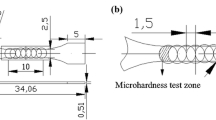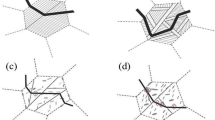Abstract
The thermal damage of AISI 1045 steel induced by laser surface treatment (LST), which is used to simulate the surface grinding burn, was comprehensively studied in this paper. By experimental investigation, a deep analysis was performed on the microstructure, hardness, and residual stress of the AISI 1045 steel specimens subjected to the LST process. Furthermore, the high-order modal characteristics of the AISI 1045 steel specimen were studied based on the high-frequency vibrator system. The experimental results reveal that the phase transformation-induced microstructure change, which can be reflected by hardness value, can be regarded as essential of the laser-induced thermal damage. The large tensile residual stress is another inevitable product that resulted from the LST process, which can be used to define the degree of surface grinding burn and belongs to the nondestructive classification technology for surface grinding burn by comparing with the microstructure-based classification technology. Moreover, the strain mode is more sensitive to the thermal damage of the specimen than the displacement mode and the resonant frequency, and the significant strain mode change of the specimen before and after the LST process will occur at higher vibration frequency. The findings confirm that the degree of surface grinding burn can be classified by using the X-ray diffraction (XRD) method, and the thermal damage in surface grinding process can be detected by using both the XRD method and the high-order strain mode method.
Similar content being viewed by others
References
Malkin S, Guo C (2007) Thermal analysis of grinding. CIRP Ann Manuf Techn 56:760–782
Pavel R, Srivastava (2007) An experimental investigation of temperatures during conventional and CBN grinding. Int J Adv Manuf Technol 33:412–418
Klocke F, Gorgels C, Reimann J (2009) Influence of grinding burn on the load carrying capacity of parts under rolling stress. In: Proceedings of 7th international conference on Barkhausen noise and micromagnetic testing, Aachen
Guo GQ, Liu ZQ, An QL, Chen M (2011) Experimental investigation on conventional grinding of Ti-6Al-4V using SiC abrasive. Int J Adv Manuf Technol 57:135–142
Ilman MN, Kusmono IPT (2013) Fatigue crack growth rate behavior of friction-stir aluminium alloy AA2024-T3 welds under transient thermal tensioning. Mater Des 50:235–243
Pan LY, Badrinarayan PA, James AF, Huang W, Zhang L, Hong T, Li WZ, William U, Justin CM (2013) Welding residual stress impact on fatigue life of a welded structure. Weld World 57:685–691
Wang Z, Willett P, DeAguiat PR, Webster J (2001) Neural network detection of grinding burn from acoustic emission. Int J Mach Tool Manuf 41:283–309
Yang ZS, Yu ZH (2012) Grinding wheel wear monitoring based on wavelet analysis and support vector machine. Int J Adv Manuf Technol 62:107–121
Yang ZS, Yu ZH (2013) Experimental study of burn classification and prediction using indirect method in surface grinding of AISI 1045 steel. Int J Adv Manuf Technol 68:2439–1449
Yang ZS, Yu ZH, Xie C, Huang YF (2014) Application of Hilbert–Huang transform to acoustic emission signal for burn feature extraction in surface grinding process. Measurement 47:14–21
Liu Q, Chen X, Gindy N (2006) Investigation of acoustic emission signals under a simulative environment of grinding burn. Int J Mach Tool Manuf 46:284–292
Santa-aho S, Vippola M, Sorsa A, Latokartano J, Lindgren M, Leiviskä K, Lepistö T (2012) Development of Barkhausen noise calibration blocks for reliable grinding burn detection. J Mater Process Tech 212:408–416
Santa-aho S, Vippola M, Sorsa A, Lindgren M, Latokartano J, Leiviskä K, Lepistö T (2012) Optimized laser processing of calibration blocks for grinding burn detection with Barkhausen noise. J Mater Process Tech 212:2282–2293
Lomaev GV, Kharanzhevskii EV (2000) Testing of laser-quenched layers with the help of Barkhausen noise. Russ J Nondestr Test 36:631–639
Zhang XF, Lin B, Xi H (2013) Validation of an analytical model for grinding temperatures in surface grinding by cup wheel with numerical and experimental results. Int J Heat Mass Tran 58:29–42
Balart MJ, Bouzina A, Edwards L, Fizpatrick ME (2004) The onset of tensile residual stresses in grinding of hardened steels. Mater Sci Eng A 564:381–388
Lee YS, Chuang MJ (2000) A study on crack detection using eigenfrequency test data. Comput Struct 77:327–342
Khoa NV (2014) Mode shapes analysis of a cracked beam and its application for crack detection. J Sound Vib 333:848–872
Yam LH, Leung TP (1996) Theoretical and experimental study of modal strain analysis. J Sound Vib 191:251–260
Chao Z, Wei T, Liang H (2013) A compressive study of thermal damage consequent to laser surface treatment. Mater Sci Eng A 564:381–388
Thomson WT, Dahleh MD (1997) Theory of vibration with applications, 5th edn. Prentice Hall, Englewood Cliffs
Ravi D, Liew KM (2000) A study of the effect of microcrack on the vibration mode shape. Eng Struct 22:1097–1102
Yang ZS, Yu ZH, Wu HX, Chang DF (2014) Laser-induced thermal damage detection in metallic materials via acoustic emission and ensemble empirical mode decomposition. J Mater Process Tech 214:1617–1626
Standard (2004) GB/T 230.1-2004 metallic Rockwell hardness test
Maeder G, Lebrun JL, Sprauel JM (1981) Present possibilities for the X-ray diffraction method of stress measurement. NDT E Int 14:235–247
Standard (2008) ASTM E837 standard test method for determining residual stresses by the hole-drilling strain-gage method
Zhong ZW, Venkatesh VC (2009) Recent developments in grinding of advanced materials. Int J Adv Manuf Technol 41:468–480
Author information
Authors and Affiliations
Corresponding author
Rights and permissions
About this article
Cite this article
Gu, Bp., Yang, Zs., Pan, L. et al. Evolution of the microstructure, mechanical properties, and high-order modal characteristics of AISI 1045 steel subjected to a simulative environment of surface grinding burn. Int J Adv Manuf Technol 82, 253–263 (2016). https://doi.org/10.1007/s00170-015-7364-z
Received:
Accepted:
Published:
Issue Date:
DOI: https://doi.org/10.1007/s00170-015-7364-z




